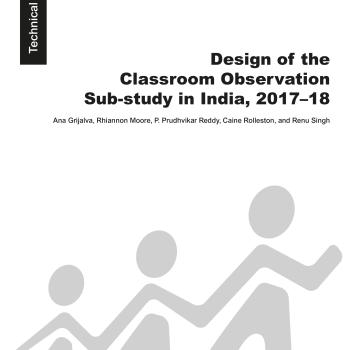Publication Information

During 2017-18, Young Lives undertook a classroom observation study in Andhra Pradesh and Telangana, India. Building upon data from Young Lives’ 2016-17 school effectiveness survey, the sub-study offers the opportunity to understand more about what is happening in the classroom, and how this is associated with variation in student learning gain. Data collected through this sub-study can be used to address research questions with a great deal of policy relevance in Indian secondary education, such as:
To what extent do teacher-student classroom interactions explain differences in student learning attainment in secondary classrooms? What in terms of observed interactions in the classroom explains higher and lower effectiveness (value-added)? What are the characteristics of classroom environments where students learn more? How do teacher-student interactions vary between different types of schools, and between schools in different localities?
The classroom observations were conducted using the CLASS-Secondary (Classroom Assessment Scoring System) tool for classroom observation. The comprehensive teacher-level data generated by use of the CLASS-S methodology provide detailed aggregate information of some of the teaching practices which make a difference to student learning. This technical note provides an overview of the sub-study design and implementation, including details of the validation of the CLASS instrument for use in the Indian context.

During 2017-18, Young Lives undertook a classroom observation study in Andhra Pradesh and Telangana, India. Building upon data from Young Lives’ 2016-17 school effectiveness survey, the sub-study offers the opportunity to understand more about what is happening in the classroom, and how this is associated with variation in student learning gain. Data collected through this sub-study can be used to address research questions with a great deal of policy relevance in Indian secondary education, such as:
To what extent do teacher-student classroom interactions explain differences in student learning attainment in secondary classrooms? What in terms of observed interactions in the classroom explains higher and lower effectiveness (value-added)? What are the characteristics of classroom environments where students learn more? How do teacher-student interactions vary between different types of schools, and between schools in different localities?
The classroom observations were conducted using the CLASS-Secondary (Classroom Assessment Scoring System) tool for classroom observation. The comprehensive teacher-level data generated by use of the CLASS-S methodology provide detailed aggregate information of some of the teaching practices which make a difference to student learning. This technical note provides an overview of the sub-study design and implementation, including details of the validation of the CLASS instrument for use in the Indian context.

